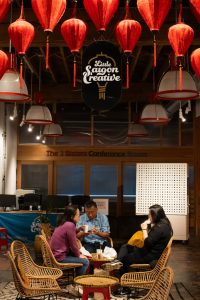
The Friends of Little Saigon (FLS) originally started as a group of volunteer community members. There was a recognition that things were happening in the community that were not in the best interest of the community. In an effort to bring a bigger voice to the people, maintain the culture and support the local small businesses, the group was formed.
In 2016, the group transitioned into a non-profit and was able to ramp up its functions and community support. The group shifted from a primarily grassroots community organization with a focus on protesting, to being more strategic with their mission. They now look to work to bring about more change and set the foundations for more long-term projects. One of those larger projects being their current landmark project: the building of centralized community spaces in the heart of Little Saigon.
The idea for the project was first formed in 2012 when the FLS asked themselves, ‘How are we going to move in a way that isn’t purely reactive? And what vision do we see for the future of Little Saigon?’
“Part of that process was to identify the community’s needs,” Tam Dinh, director of the Master of Social Work program and board president of Friends of Little Saigon, said. “Saigon is prime for development, if everything is developed without having any recognition of what the community wants, then quickly, we’re not gonna have any space in it. So we want to create our own vision.”
According to Dinh, FLS is not anti-development. They want development to happen but in a manner that seeks to preserve the identity of the Vietnamese community. The Landmark Project has three initiatives. First, to build the cultural center itself. Second, to provide a space for small businesses. Third, to ensure housing is affordable for the people who live, work and have historically always been in the little Saigon area.
“My hope is that this is just the start of real investment in the neighborhood,” Quynh Pham, executive director of the FLS, said. “I think there is a lot of pressure to make sure that this project is successful because it really will be the landmark and an anchor for the community.”
For several years now, the FLS has tried to purchase land for the project but was consistently outbid by developers with deep pockets. This led to the project being broken up into pieces. The first piece was leasing out a space to create “The Creative Space by Friends of Little Saigon.”
This project includes meeting spaces, an art showcase area, a place to sell small goods, the Vietnamese coffee shop Hello Em and plenty of space to spend time and be involved with the community.
“Through that hanging out, you get to experience another culture, another group of people who live in the Seattle area that are part of the community,” Dinh said. “We want to be welcoming to others, so that other communities can also come and utilize these spaces and feel like for that moment say, ‘Hey, this is a cool space where I’m learning something new about another culture.’”

In the last few years, the organization has been able to get funding from the city of Seattle and King County and the federal government to put together to buy the land required to continue with the next part of the Landmark project. Recently, a piece of land was purchased by the FLS to build a community center that will have small business storefronts, affordable housing and more cultural spaces.
The FLS is actively working with architects to design a space that will embody community feedback, incorporate intention and highlight Vietnamese culture.
This space will be used to curate and host Vietnamese artists, Vietnamese writers, dance classes, book clubs and other events. The space will be available for all community members who want to utilize it.
FLS sees small businesses and their owners as the community backbone of Little Saigon. That is why the community center will also include retail space for local small business owners to operate their shops and restaurants until they are in a place to expand. The goal is for these spots to be rent-subsidized to make operating the businesses easier.
“Our landmark project is not the antidote for anything,” Dinh said. “But it’s a step forward. Everything that we do is a reminder to the city of what it could be, of how it should be.”
By building this project, FLS also hopes to set an example for developers and the city on how to handle development in a way that benefits communities instead of erasing them.
Julie Pham, vice president of the Seattle U Vietnamese Student Association (SUVSA), expressed her excitement about the cultural center.
“Part of Seattle U’s mission is to educate the whole person and to empower leaders for a just and humane world,” Phạm said. “The center’s purpose of providing a commercial and retail space as well as affordable housing… aligns with SUVSA and SU’s mission. We are excited to see an area of sanctuary for the Vietnamese community that extends toward our SUVSA community.”
Dinh prompted students to go out into the neighborhoods in and around Seattle and think about what communities they want to live in. After thinking about that, bring the discussion of the community into the classroom and bring visibility to community issues and positive changes.








